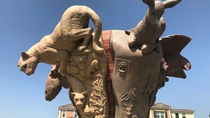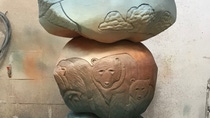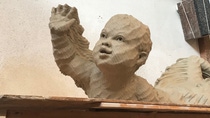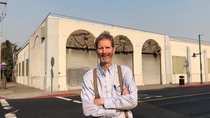Media
Artist leaves his mark on the world thanks to BASF’s durable concrete product
A professional sculptor shares his life journey that led him to MasterEmaco repair mortar.
.jpg)
Scott Donahue is a successful sculptor who creates major public art installations out of concrete, among other materials. And his sculptures are quite a sight to see. One of his more recent pieces installed at a new park in Milpitas, Silicon Valley, looks like it’s taken straight out of Noah’s Ark story. A mountain lion, a deer, a hawk, a raccoon and a steelhead trout sit atop of a 12-foot-high monument made from concrete that’s laminated by hand with fiberglass mesh.
As a professional artist in Emeryville, California, Donahue is kept quite busy. When developers are not commissioning him to do public art in their buildings to improve the value of their properties, wealthy private citizens ask him for personal pieces for their homes.
You could say Donahue is living the life everyone dreams—doing what he loves, being creative and getting paid for it. But that wasn’t always the case for Donahue. In fact, he almost didn’t go to art school.
“My father died when I was 14, so there wasn’t any money for me to go to school,” said the former New Jersey native. “But I won a scholarship for the first year of art school.”
Between having an electrical engineer father whom Donahue watched build a boat in their basement and a biologist mother who worked with chemical processes, he felt like he "could make anything.”
After graduate art school, young Donahue initially started working as a carpenter. Later he had a gallery and was able to sell his artwork there. But after a 1987 stock crash times got hard and the gallery ended up in debt. Things turned for the worst when at age 36 he was diagnosed with bone cancer—the same illness from which his father had died. After his second surgery, doctors were giving him at most two years to live with the slight possibility of a normal life span.
That’s when Donahue had an epiphany to leave his mark on the world, and he would do it in two ways—have a child with his wife and create art that’s durable and lasting over a century, at least.
“I just felt compelled to leave my mark in a way that would be visible,” said Donahue, “not in the mostly-rich-people’s homes that were buying my art that would never be seen by the public or my friends who were all artists. No, I wanted public art.”
In addition to creating public art per se, Donahue also wanted to work with concrete materials that were built to last.
“If concrete is done properly, it can be very durable,” he added. “If you don’t build properly, with steel that is not properly prepared, it is going to rust and within 50 years it’s history; 50 years is not acceptable (for concrete), try 150 years.”
The artist read an article about how sculptors in England use calcium aluminates and fiberglass to create sculptures and decided to follow suit.
“Calcium aluminates are better than Portland cement for resisting acidic air that most urban air has, and at the same time they cure in 24 hours,” he said.


Several years later, after Donahue survived his two-year predicament and became not only a successful artist and father, but also the mayor of his town in Emeryville, he started searching for a good overhead repair mortar. This mortar had to have high compressive strength that reduces moisture infiltration in cement, especially for his outdoor pieces. That’s when he stumbled upon a presentation by John Bettencourt, Key Accounts Manager, Construction Systems, BASF at a small concrete exhibit in Hayward, California.
After Donahue expressed his needs for the type of work he did—Bettencourt recommended just the right product for him—MasterEmaco N 420 CI—a non-sag concrete repair mortar with an integral corrosion inhibitor for vertical and overhead applications. Bettencourt figured since this product had fibers in it, it would hold together very well for the specific work that Donahue did.
“In my view, this is a cementitious product, it won’t slump or fall off the wall,” said Bettencourt. “Most importantly, a corrosion inhibitor is already in the product and it’s polymer-modified right out of the bag—you don’t have to add any polymers to it.”
Additionally, specific to Donahue’s job—this repair mortar not only hardens well but shapes and cuts without chattering—meaning you can cut a precise clean edge into it with a tool without the corners of the edge unraveling or chattering apart, according to Bettencourt.
The BASF employee gave Donahue a 50-pound bag to sample the product, and the artist never looked back.
“What I like about this product is it has better detail for going inside of a plaster waste mold, and I can laminate inside of these plaster waste molds efficiently and the results are very good,” said Donahue. “It is very controllable in a vertical mold and the rheology is just right.”
The artist has been utilizing BASF’s repair mortar for the past year and a half—since he’s heard of it. In fact, he used MasterEmaco N 420 CI to make his Milpitas project channeling Noah’s Ark. Instead of paint, however, Donahue used water glass on the artwork, which is crystallized silicates; it’s water resistant and it will never peel off.
Donahue is currently working on two projects for which he’s using BASF’s repair mortar —one commissioned by a private citizen to go over his fireplace and another for a major medical center in Fremont, California.
It seems like the artist’s wish to leave his mark on the world has indeed become a reality. While Donahue might not be a typical BASF customer, such as a concrete contractor, he sure is a memorable one.
“Scott is just a very unique customer and a pleasure to deal with,” Bettencourt added. “What his (art) use showed was how versatile this product is, how shapeable it is and how these products could be used outside the norm.”

Published by Anna Spiewak.
For media inquiries or to repurpose this article, please contact Lisa Brown.